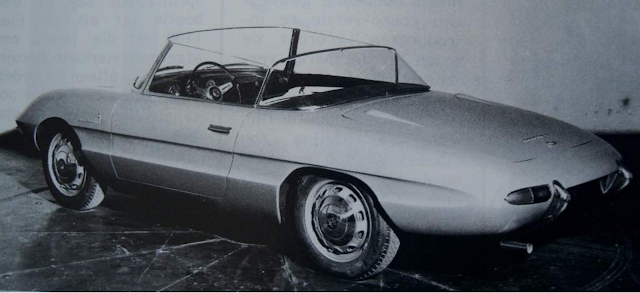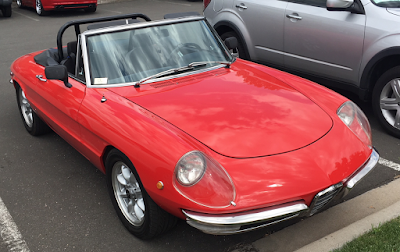Flying saucers were what Frank Zappa called a real scene in the early 1950s; it seemed everyone was thinking about them, and not just in science fiction stories and films. When Alfa Romeo commissioned the designers at Touring Superleggera to create a prototype for a new line of sports cars, they came up with the form pictured below, and they called it the Disco Volante, "flying saucer."
This was heady stuff in 1952. The design team working under Felice Bianchi Anderloni contrived to organize the form around a horizontal break in the surface accented by bright metal and linking the air intakes at the front to the lights at the sharply tapered tail. The shallow, convex teardrop shape (after all, nobody said all saucers had to be round) of the upper body flowed into four smaller teardrops housing the wheels and two streamlined headrests for driver and passenger.
The lenticular body section was intended to reduce sensitivity to crosswinds and allowed largely enclosed wheels. These ideas were tested in a wind tunnel and on the track at Monza. When the Disco Volante first appeared at the Turin Show, it was demonstrated by a model who tried to look cheerful despite her Flash Gordon space suit; unfortunately I've lost the photo link. Perhaps one of the Alfisti who occasionally comments here can send it…
In 1953 one of the three original spiders was made into a coupe with a teardrop roof and small doors that grudgingly permitted entry. The engine in the first three cars was a 2 liter inline four based on the 1900 engine, but with an aluminum block. Twin overhead cams were featured in an alloy head on this engine and the larger 3.5 liter six, but that engine had a cast iron block. Derived from the 6C 3000CM racers, it would power the last two Disco Volantes built; four of the five cars survive. Chassis design was advanced, with a tubular space frame and De Dion rear suspension…
When it appeared that the wide bodies of the prototypes would reduce the car's effectiveness in races on narrow public roads, Anderloni's crew at Touring then re-bodied one of the cars as a Disco Volante a fianchi stretti, or narrow-sided Flying Saucer. Carrozzeria Colli, known mostly for making Alfa limousines and station wagons, built a coupe with similar narrow flanks for the 6C 3000 CM chassis, and Alfa entered 3 of these cars in the 1953 Mille Miglia. Around the halfway mark in this thousand mile race on public roads, Juan Manuel Fangio's Alfa coupe, #602 shown above, was leading the race after accidents claimed another Alfa, a Ferrari and a Mercedes. Then, with nearly 500 miles to go, a steering link broke, and Fangio had only one steerable wheel. Somehow he managed an epic drive to finish in 2nd place behind a Ferrari. Soon the public attached the Disco Volante name to all these racing Alfas, and their fame spread...
But not enough to get them into production; instead the company put most of its efforts into getting the new, smaller Giulietta* into production. When their racing careers were over, a couple of Alfa's 6C racers were re-bodied as road cars. Fangio's famous Mille Miglia coupe was re-bodied in 1956 by Pinin Farina as Superflow I, a show car and mobile test bed for new ideas. These ideas included the plexiglass roof with panels that pivoted upward above the doors, and an ovoid body section with canted tail fins and deep side indents painted dark blue. The most unusual feature was provision of clear plexiglass fender tops which allowed a view of the front wheels and the separate, polished headlight units. The likely reason for this innovation was to allow the driver the same view of the front wheel position as on an open-wheel race car. It may also have been prompted by an attempt to re-introduce the elegant separation of elements (fenders, lights, radiators) from classic cars of the 1930s.
The overall effect of these features on the frontal aspect seemed contrived, however, especially when combined with the apparently added-on grille nacelle. Also, critics pointed out that the clear fender tops would not stay clear of road grime and stone chips for long...
So, later in 1956, Pinin Farina remodeled the same car into Superflow II shown below, replacing the transparent fender tops with metal ones, and the separate headlamp pods gave way to headlights under plexiglass bubbles. Even the traditional Alfa grille was replaced by a simple hood scoop and a low air intake.
Superflow II got a new paint scheme, with the concave side coves painted white against the red bodywork.
Pinin Farina's fascination with transparency continued in another form on this version, with taller tail fins incorporating plexiglass upper sections to allow better rearward vision. Apparently heat gain inside the transparent cabin proved problematic, as a rooftop vent, visible in the photo below, was installed after the color photo above was taken. In going to all-metal front fenders, PF introduced air extractor vents into their tops just forward of the windshield, most visible in the photo below.
By 1959, Pinin Farina decided to simplify the car once again, and Superflow III was born. This version was an open spider rendered in white, still with the concave coves along the car's flanks. The headlights were now uncovered, and the frameless top of the windshield, along with the large faired-in headrests, would seem to argue against provision of a practical convertible top. Those headrests may be a reference to the same feature on the original Disco Volante from 1952. Liberated from the need for soon-to-be-outmoded tail fins, the designers emphasized the rounded tail with neat wraparound tail lights...
Not yet satisfied with the overall form or details, the PF team kept their panel-beaters busy by remodeling the entire car one last time in 1960. A close examination shows that the restless search for perfection has led to revising nearly all the body panels as well as the transparent roof. In the view below, the covered headlights and smoother fender profiles are visible, along with a new windshield frame. The form of the front fender vent is repeated on the rear fender...
Also, the concave cove along the car's flanks has been removed and replaced by a shallow, simple indent. The roof now features a structural rib running down the center.
This detail shows the side windows are curved in section and are removable rather than the wind-down type. Like the most Alfa race cars from the early 1950s, the 6C 3000CM chassis has right-hand drive.
This car has recently been repainted in racing red, but its forms and surfaces may have been served best by the muted metallic red it wore when it appeared in Road & Track. The year after Superflow IV appeared, Pininfarina (now all one name) showed a smaller prototype incorporating many of the ideas from the Superflow series.
This was the 1961 Giulietta SS Spider Aerodinamica, based upon the popular 1300cc Alfa Giulietta series. In the two photos above, the rounded tail, indented side coves, and smoothly contoured front end with faired-in headlights (in this case, retractable units) all echo the Superflows. They demonstrate the persistent, slow search for workable ideas that Pininfarina conducted in order to arrive at a form for Alfa's new 1600 Duetto spider, which would finally arrive in 1966. At the introduction of the new model, some automotive writers commented that the form was not especially striking or innovative. This may have been because they'd been seeing variations on this form at auto shows for a full ten years. But this original "round-tail" Duetto's details, from the covered headlights from Superflow IV, to the deftly integrated front bumper and grille from the 1961 Spider Aerodinamica, worked well together. The two cars shown below were photographed at a show this summer, and are in regular use. Aside from the aftermarket wheels and mirrors, they are testimony to a patient, careful process of trial and error leading to a car that still looks as modern as its original, fresh-faced self, half a century later.
*Footnotes:
The Alfa Romeo Giulietta sports models are featured in posts entitled "Max Hoffman: An Eye for Cars" for 5-1-16 and in "Unsung Genius: Franco Scaglione" for 12-20-17. These can be found in the Archives.
Photo Credits:
Top: pinterest.com
2nd & 3rd: wikimedia
4th: jmfangio.org
All photos of Superflow I, II & III: Pininfarina S.p.A.
Black & white photos of Superflow IV: Pininfarina S.p.A.
Color shot of Superflow IV: wikimedia
1961 Spider Aerodinamica: Pininfarina S.p.A.
Production Duettos in color: the author




















This is fantastic! I have a duetto, and I have spent a great deal of time thinking about the influences leading to Batista Farina's last design. I laid eyes on one in college in the 80s, and wanted one ever since. It seems to me that this design, panned by the press when unveiled, was the epitome and swan song of the curvatious era.
ReplyDeleteI do think some of the Bertone designs of the period deserve mention, specifically the grill of the Bertone giulietta prototype entered in the contest the design the Giulietta spider .
Thank you for gathering the bits of this story.
Glad you enjoyed this, Walter; thanks for having a look. We posted shots of the 2 different Bertone Giulietta spider prototypes on July 4, 2019, in "Roadside Attraction: Swiss Museum of Transport——Alfa to Zagato, and Everything in Between." Like the Giulietta Sprint and Sprint Speciale (the latter showed up in our post for May 24, 2025: "Sunday Morning Dog Show with Cars: A Sequel"), it was designed by Franco Scaglione. We posted a retrospective of Scaglione's work for Bertone on Dec. 20, 2017 entitled "Unsung Genius Franco Scaglione: The Arc of Success."
ReplyDelete